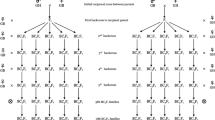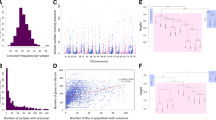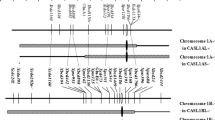Abstract
Key message
This study reports transmission genetics of chromosomal segments into Gossypium hirsutum from its most distant euploid relative, Gossypium mustelinum . Mutilocus interactions and structural rearrangements affect introgression and segregation of donor chromatin.
Abstract
Wild allotetraploid relatives of cotton are a rich source of genetic diversity that can be used in genetic improvement, but linkage drag and non-Mendelian transmission genetics are prevalent in interspecific crosses. These problems necessitate knowledge of transmission patterns of chromatin from wild donor species in cultivated recipient species. From an interspecific cross, Gossypium hirsutum × Gossypium mustelinum, we studied G. mustelinum (the most distant tetraploid relative of Upland cotton) allele retention in 35 BC3F1 plants and segregation patterns in BC3F2 populations totaling 3202 individuals, using 216 DNA marker loci. The average retention of donor alleles across BC3F1 plants was higher than expected and the average frequency of G. mustelinum alleles in BC3F2 segregating families was less than expected. Despite surprisingly high retention of G. mustelinum alleles in BC3F1, 46 genomic regions showed no introgression. Regions on chromosomes 3 and 15 lacking introgression were closely associated with possible small inversions previously reported. Nonlinear two-locus interactions are abundant among loci with single-locus segregation distortion, and among loci originating from one of the two subgenomes. Comparison of the present results with those of prior studies indicates different permeability of Upland cotton for donor chromatin from different allotetraploid relatives. Different contributions of subgenomes to two-locus interactions suggest different fates of subgenomes in the evolution of allotetraploid cottons. Transmission genetics of G. hirsutum × G. mustelinum crosses reveals allelic interactions, constraints on fixation and selection of donor alleles, and challenges with retention of introgressed chromatin for crop improvement.




Similar content being viewed by others
References
Anderson E (1949) Introgressive hybridization. Wiley/Chapman and Hall, New York/London
Benbouza H, Lacape J, Jacquemin J, Courtois B, Diouf F, Sarr D, Konan N, Baudoin J-P, Mergeai G (2010) Introgression of the low-gossypol seed & high-gossypol plant trait in upland cotton: analysis of [(Gossypium hirsutum × G. raimondii)2 × G. sturtianum] trispecific hybrid and selected derivatives using mapped SSRs. Mol Breed 25:273–286
Brown MS (1980) Identification of the chromosomes of Gossypium hirsutum L. by means of translocations. J Hered 71:266–274
Chee PW, Rong J, Williams-Coplin D, Schulze SR, Paterson AH (2004) EST derived PCR-based markers for functional gene homologues in cotton. Genome 47:449–462
Cx Jiang, Wright RJ, El-Zik KM, Paterson AH (1998) Polyploid formation created unique avenues for response to selection in Gossypium (cotton). PNAS 95:4419–4424
Dreisigacker S, Zhang P, Warburton M, Skovmand B, Hoisington D, Melchinger A (2005) Genetic diversity among and within CIMMYT wheat landrace accessions investigated with SSRs and implications for plant genetic resources management. Crop Sci 45:653–661
Endrizzi J, Turcotte E, Kohel R (1984) Qualitative genetics, cytology, and cytogenetics. Cotton 24:81–129
Etterson JR, Keller SR, Galloway LF (2007) Epistatic and cytonuclear interactions govern outbreeding depression in the autotetraploid Campanulastrum americanum. Evolution 61:2671–2683
Flagel LE, Wendel JF (2010) Evolutionary rate variation, genomic dominance and duplicate gene expression evolution during allotetraploid cotton speciation. New Phytol 186:184–193
Galvan M, Bornet B, Balatti P, Branchard M (2003) Inter simple sequence repeat (ISSR) markers as a tool for the assessment of both genetic diversity and gene pool origin in common bean (Phaseolus vulgaris L.). Euphytica 132:297–301
Gur A, Semel Y, Osorio S, Friedmann M, Seekh S, Ghareeb B, Mohammad A, Pleban T, Gera G, Fernie AR (2011) Yield quantitative trait loci from wild tomato are predominately expressed by the shoot. Theor Appl Genet 122:1–16
Hodgkin T, Hajjar R, Maxted N, Ford-Lloyd B, Kell S, Iriondo J, Dulloo M, Turok J (2007) Using crop wild relatives for crop improvement: trends and perspectives. In: Proceedings of the first international conference on crop wild relative conservation and use, Sicily, 14–17 Sep 2005. CABI, pp 535–548
Jiang CX, Chee PW, Draye X, Morrell PL, Smith CW, Paterson AH (2000) Multilocus interactions restrict gene introgression in interspecific populations of polyploid Gossypium (cotton). Evolution 54:798–814
Levi A, Ovnat L, Paterson AH, Saranga Y (2009) Photosynthesis of cotton near-isogenic lines introgressed with QTLs for productivity and drought related traits. Plant Sci 177:88–96
Li X, Wang X, Wei Y, Brummer EC (2011) Prevalence of segregation distortion in diploid alfalfa and its implications for genetics and breeding applications. Theor Appl Genet 123:667–679
Mangelsdorf PC, Jones DF (1926) The expression of Mendelian factors in the gametophyte of maize. Genetics 11:423
May OL, Bowman DT, Calhoun DS (1995) Genetic diversity of US upland cotton cultivars released between 1980 and 1990. Crop Sci 35:1570–1574
Mercado L, Souza E, Kephart K (1996) Origin and diversity of North American hard spring wheats. Theor Appl Genet 93:593–599
Paterson AH, Brubaker CL, Wendel JF (1993) A rapid method for extraction of cotton (Gossypium spp.) genomic DNA suitable for RFLP or PCR analysis. Plant Mol Biol Rep 11:122–127
Rieseberg LH, Kim MJ, Seiler GJ (1999) Introgression between the cultivated sunflower and a sympatric wild relative, Helianthus petiolaris (Asteraceae). Int J Plant Sci 160:102–108
Rong J, Abbey C, Bowers JE, Brubaker CL, Chang C, Chee PW, Delmonte TA, Ding X, Garza JJ, Marler BS (2004) A 3347-locus genetic recombination map of sequence-tagged sites reveals features of genome organization, transmission and evolution of cotton (Gossypium). Genetics 166:389–417
Snedecor GW, Cochran WG (1980) Statistical methods. Iowa State University Press, Iowa
SAS S, Sofware S (2011) Version 9.3. NC SAS Institute Inc, Cary
Tanksley S, Nelson J (1996) Advanced backcross QTL analysis: a method for the simultaneous discovery and transfer of valuable QTLs from unadapted germplasm into elite breeding lines. Theor Appl Genet 92:191–203
Tyagi P, Gore MA, Bowman DT, Campbell BT, Udall JA, Kuraparthy V (2014) Genetic diversity and population structure in the US Upland cotton (Gossypium hirsutum L.). Theor Appl Genet 127:283–295
Waghmare VN, Rong J, Rogers CJ, Bowers JE, Chee PW, Gannaway JR, Katageri I, Paterson AH (2016) Comparative transmission genetics of introgressed chromatin in Gossypium (cotton) polyploids. Am J Bot 103:719–729
Wang B, Draye X, Zhang Z, Zhuang Z, May OL, Paterson AH, Chee PW (2016a) Advanced backcross quantitative trait locus analysis of fiber elongation in a cross between Gossypium hirsutum and G. mustelinum. Crop Sci 56:1760–1768
Wang B, Liu L, Zhang D, Zhuang Z, Guo H, Qiao X, Wei L, Rong J, May OL, Paterson AH (2016b) A genetic map between Gossypium hirsutum and the Brazilian endemic G. mustelinum and its application to QTL mapping. G3 6:1673–1685
Wendel JF, Cronn RC (2003) Polyploidy and the evolutionary history of cotton. Adv Agron 78:139–186
Wendel JF, Brubaker CL, Percival AE (1992) Genetic diversity in Gossypium hirsutum and the origin of upland cotton. Am J Bot 79:1291–1310
Wendel JF, Schnabel A, Seelanan T (1995) Bidirectional interlocus concerted evolution following allopolyploid speciation in cotton (Gossypium). PNAS 92:280
Wu Q, Liu F, Li S, Song G, Wang C, Zhang X, Wang Y, Stelly D, Wang K (2013) Uniqueness of the Gossypium mustelinum genome revealed by GISH and 45S rDNA FISH. J Integr Plant Biol 55:654–662
Yang J, Zhao X, Cheng K, Du H, Ouyang Y, Chen J, Qiu S, Huang J, Jiang Y, Jiang L (2012) A killer-protector system regulates both hybrid sterility and segregation distortion in rice. Science 337:1336–1340
Yu L-X, Nguyen HT (1994) Genetic variation detected with RAPD markers among upland and lowland rice cultivars (Oryza sativa L.). Theor Appl Genet 87:668–672
Zamir D (2001) Improving plant breeding with exotic genetic libraries. Nat Rev Genet 2:983–989
Zhang L, Wang S, Li H, Deng Q, Zheng A, Li S, Li P, Li Z, Wang J (2010) Effects of missing marker and segregation distortion on QTL mapping in F2 populations. Theor Appl Genet 121:1071–1082
Zhang Z, Rong J, Waghmare VN, Chee PW, May OL, Wright RJ, Gannaway JR, Paterson AH (2011) QTL alleles for improved fiber quality from a wild Hawaiian cotton, Gossypium tomentosum. Theor Appl Genet 123:1075–1088
Zhu H, Han X, Lv J, Zhao L, Xu X, Zhang T, Guo W (2011) Structure, expression differentiation and evolution of duplicated fiber developmental genes in Gossypium barbadense and G. hirsutum. BMC Plant Biol 11:1
Acknowledgements
Authors sincerely thank the members of Plant Genome Mapping Lab and Molecular Cotton Breeding Lab for help in lab and field work. We thank Curt Brubaker for initial crossing in population development. We also thank the National Science Foundation for financial support.
Author information
Authors and Affiliations
Corresponding author
Ethics declarations
Conflict of interest
The authors declare that they have no conflict of interest.
Additional information
Communicated by Joshua Udall.
Rights and permissions
About this article
Cite this article
Chandnani, R., Wang, B., Draye, X. et al. Segregation distortion and genome-wide digenic interactions affect transmission of introgressed chromatin from wild cotton species. Theor Appl Genet 130, 2219–2230 (2017). https://doi.org/10.1007/s00122-017-2952-y
Received:
Accepted:
Published:
Issue Date:
DOI: https://doi.org/10.1007/s00122-017-2952-y




